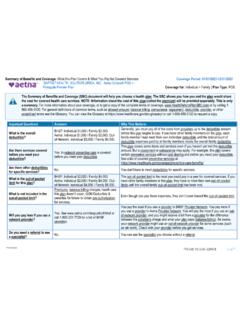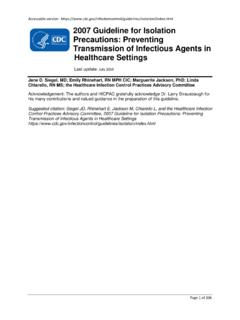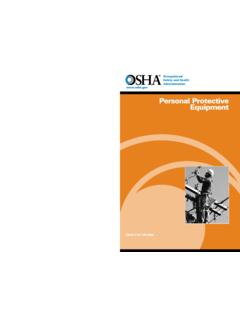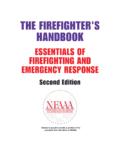Transcription of Baptist Health Workplace Health & Safety
1 Baptist Health Workplace Health & SafetyCOVID-19 Workplace Safety Training 2021 Revised , July 16, 2021 LCollado1 Training ObjectivesThis training reinforces previously provided COVID-19 education and training of all Workplace Safety and infection prevention & control measures at Baptist Health . In addition, this training provides information found in the Baptist Health COVID-19 Workplace Safety Plan (CWSP) and the OSHA Healthcare COVID-19 Emergency Temporary Standard (ETS). Both related policies/procedures and the Baptist Health CWSP include key preventive and protective measures to be used to prevent/minimize your potential Workplace exposure risk to COVID-19, to include.
2 Following appropriate Health screening and triage protocols for employees/ medical staff members and non-employees ( patients, visitors, and vendors), Maintaining adequate physical distancing and proper use of physical barriers, where necessary, The proper useand limitations of Baptist Health -supplied facemasks (for source control) and Personal Protective Equipment (PPE), Proper cleaning and disinfection protocols of the environment and equipment, Understanding Baptist Health s Leave policy and other COVID-19 related resources, The identity and contact information of your entity-specific COVID-19 Safety Coordinator(s), and How to obtain copies of the Baptist Health CWSP, and other key existing polices, procedures, and tools2 Baptist Health COVID-19 Workplace Safety Plan (CWSP)
3 The Baptist Health CWSP incorporates key elements found in existing Safety , infection prevention & control plans, policies and procedures throughout Baptist Health . The Baptist Health CWSP is consistent with Centers for Disease Control and Prevention (CDC) guidelines, Food and Drug Administration (FDA) regulations and advisories, and OSHA regulations, including the OSHA ETS. Relevant policies and procedures include: Baptist Health COVID-19 Workplace Safety Plan (CWSP), BHSF 66490-10300 BHSF Visitation Guidelines during the COVID-19 Pandemic, BHSF BHSF Universal Masking during the COVID-19 Pandemic, BHSF BHSF Policy Prohibiting Harassment and Discrimination, BHSF-5075 BHSF Respiratory Protection Program, BHSF Pandemic Preparedness Plan, BHSF 66490-403 Above policies/ procedures are available in the Baptist Health intranet by clicking the following link.
4 Baptist Health South Florida Administrative Policies ( ) The virus that causes COVID-19 spreads most commonly through person-to-person contact (within about 6 feet of each other), primarily through the inhalation of respiratory particles (droplets and aerosols) produced when an infected person exhales, talks, sings, shouts, coughs, or sneezes. An infected person can spread the virus before they show symptoms (pre-symptomatic) or without ever showing symptoms (asymptomatic). Less commonly, the virus spreads over longer distances when smaller droplets or particles linger in the air, particularly indoor settings with inadequate ventilation.
5 Another less common way the virus can spread is when someone touches a contaminated surface, and then touches their nose, mouth, or eyes. For complete list of risk factors please see the following CDC link: Certain Medical Conditions and Risk for Severe COVID-19 Illness | CDCR eview of COVID-19 Transmission4 Variants of the Virus that Causes COVID-19 Information about the characteristics of these variants is rapidly emerging. Scientists are working to learn more about how easily they spread, whether they could cause more severe illness, and whether currently authorized vaccines will protect people against them.
6 Viruses constantly change through mutation, and new variants of a virus are expected to occur. Sometimes new variants emerge and disappear. Other times, new variants persist. Multiple variants of the virus that causes COVID-19 have been documented in the United States and globally during this pandemic. Variants in the United States (as of July 2021): (Alpha): This variant was first detected in the United States in December 2020. It was initially detected in the United Kingdom. (Beta): This variant was first detected in the United States at the end of January 2021.
7 It was initially detected in South Africa in December 2020. (Gamma): This variant was first detected in the United States in January 2021. was initially identified in travelers fromBrazil, who were tested during routine screening at an airport in Japan, in early January. (Delta): This variant was first detected in the United States in March 2021. It was initially identified in Indiain December 2020. Some of these variants seem to spread more easily and quickly, which may lead to more cases of COVID-19.
8 An increase in the number of cases will put more strain on healthcare resources, lead to more hospitalizations, and potentially more deaths. So far, studies suggest that the current authorized vaccines work on the circulating variants. Scientists will continue to study these and other and Symptoms of COVID-19 For the most updated list of symptoms please go to the following link:Symptoms of COVID-19 | CDC If you are sick Notify your leader & Occupational Health , stay home, isolate from others.
9 Contact your local healthcare provider and get tested if you have symptoms of of entry point screening tool/ signage for patients and visitorsNote: Screening Tool subject to changeProtect Yourself and Others7 Cover coughs and sneezesClean your hands oftenClean and disinfectAvoid close contactWear a mask when around othersHand Hygiene and Respiratory Etiquette 8 Handwashing: Clean Hands Save Lives | CDCS creening and Triage Protocols Limit entry points and screen individuals entering the facility for COVID-19 symptoms, regardless of vaccination status.
10 Note: reference current Baptist Health s Facility-Entry Point Screening Protocols and Visitation Guidelines during the COVID-19 Pandemic In addition to screening protocols, individuals who may be experiencing COVID-19 symptoms or are COVID-19 positive will be triaged and isolated as Health s Facility-Entry Point Screening Protocols Note: Screening protocols are subject to changeEmployee and Medical Staff Health Screening and Medical Management* All Baptist Health employees and medical staff members must self-monitor for COVID-19 symptoms prior to each work day/shift.












